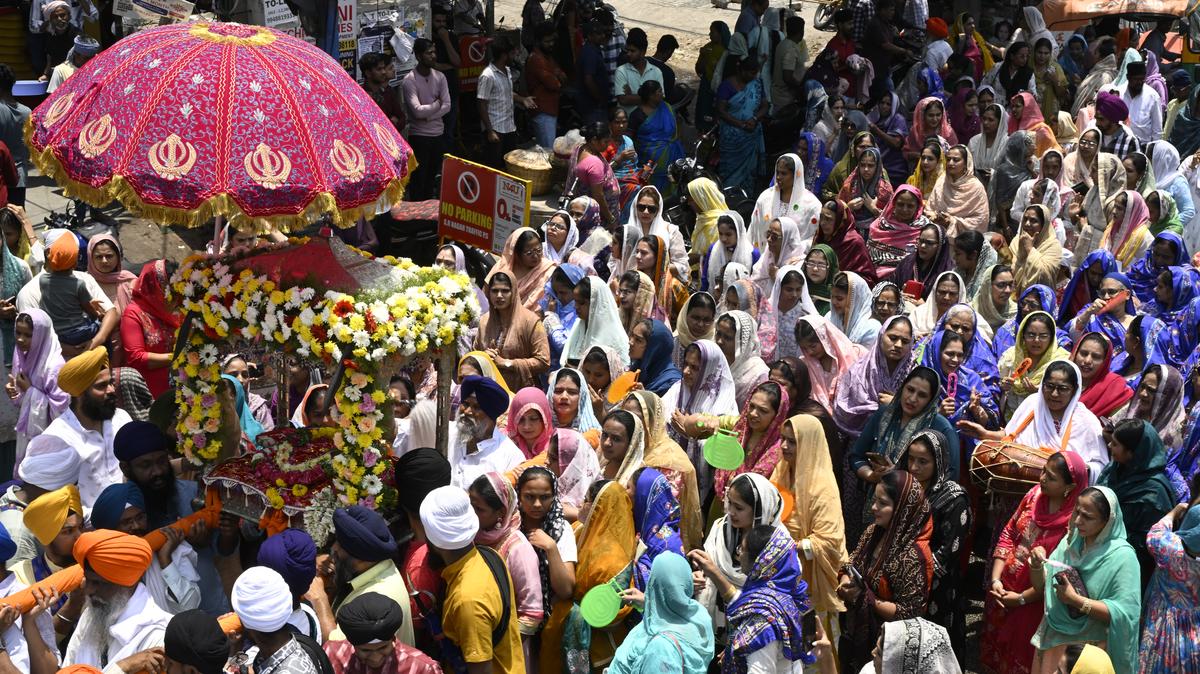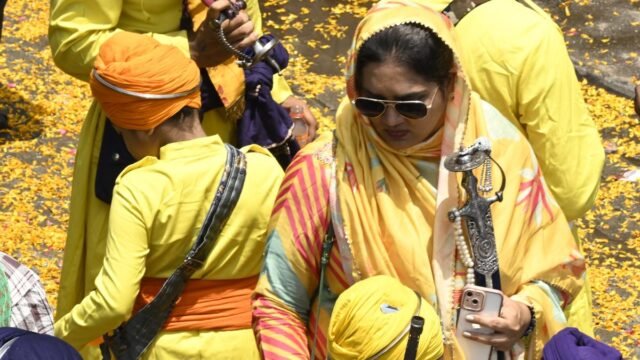
Sikhs participating in a procession on Baisakhi in Hyderabad on Sunday.
| Photo Credit: RAMAKRISHNA G.
On Sunday, Hyderabad’s blazing sunlight was gently complemented by hues of yellow, seen in the vibrant attire of devotees, marigold garlands, and decorations draping gurudwaras, as the city came together to celebrate Baisakhi.
The path to the decades-old Ameerpet Gurudwara was shaded by a canopy of fluttering yellow flags, while makeshift stalls along the way offered chabeel, a cool, sweetened rose drink,and spiced buttermilk to passersby. About 700 metres from the gurudwara, tucked within the quiet, leafy lanes of Ameerpet, the Ameerpet MCH Stadium, also known as the Sri Guru Gobind Singh Ji Cricket Academy, had been transformed for the day, with a large marquee set up to host a community religious gathering. This served as the focal point of the day’s celebrations, drawing Sikhs from across Hyderabad.
At the entrance, a line of chabeel stalls on either side of the entrance stood ready, offering much-needed relief to all who passed by. Food delivery agents paused mid-route, traffic and other police personnel briefly stepped aside from duty in turns, local commuters slowed their hurried steps, and devotees arriving for prayers all stopped to savour the refreshing drinks, grateful for the momentary respite it brought amid the heat.
Inside, health and blood donation camps were set up alongside stalls selling ornaments and accessories of religious significance. Devotees lined up to enter the main pandal (tent), where kirtan (religious hymns) filled the air. To the right, the langar (community kitchen) was in full swing, with volunteers serving hot rice, dal, matar paneer,soft rotis, and jalebi to devotees sitting in orderly queues.
Union Minister G. Kishan Reddy and BJP party members visited the gurudwara to offer prayers and join the celebrations.
The day-long celebration concluded with the Nagar Kirtan, a religious procession that wound its way through key areas like Greenlands, Begumpet, and Punjagutta. Devotees walked together, singing hymns while the holy scripture, Guru Granth Sahib, was carried in a decorated palanquin. Along the route, devotees offered voluntary service — sweeping the streets, distributing food and offering water to participants.

Sikhs participating in a procession on Baisakhi in Hyderabad on Sunday.
| Photo Credit:
RAMAKRISHNA G.
Baisakhi holds dual significance for the Sikh community, celebrating both religious tradition and agrarian roots. For Sikhs, it marks a historic turning point — the day in 1699 when the tenth Guru, Guru Gobind Singh, founded the Khalsa Panth. Members of the Khalsa were given the names Singh and Kaur, identified by five distinct symbols, and were called to lead lives of courage, discipline and integrity. For farmers across north India, Baisakhi signals the harvest of rabi crops, especially wheat, marking the beginning of a new agricultural cycle.
Much like the vibrant village melas of Punjab, Hyderabad wrapped up its Baisakhi celebrations with a gathering at the Hyderabad International Convention Centre, in the heart of the city’s IT corridor. The evening came alive with a live folk music performance by celebrated singer and songwriter Gurdas Maan. Traditional bhangra and gidda performances and a spread of authentic Punjabi food completed the evening.
Published – April 14, 2025 02:19 am IST







